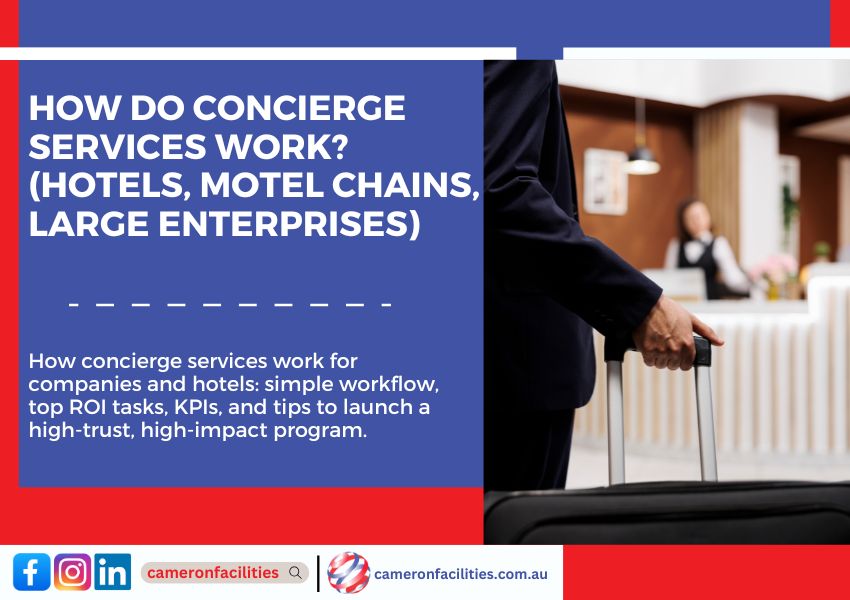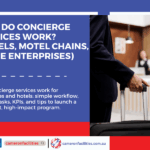
Anything you need to know about concierge services for hotels, motel chains, and large enterprises
If your team loses hours to everyday errands, or your guests can’t get the “impossible” table, a concierge can bridge the gap. In simple terms, a concierge makes things happen for you. They take the request, do the legwork, and close the loop.
This guide explains how concierge services work in corporate settings and in hospitality. We’ll keep it practical: how requests flow, who pays for what, what to track, and common pitfalls. For context on why employers care about convenience benefits, see the SHRM Employee Benefits Survey (trend overview on workplace perks) — SHRM benefits overview. For hospitality standards, the global association Les Clefs d’Or outlines the profession’s ethics and methods — Les Clefs d’Or: What is a Concierge?.
What exactly is a concierge service today?
A concierge is a trusted point person who takes tasks off your plate. In hotels, they serve guests. In companies, they support employees or executives. Many services run as a hybrid: a staffed desk plus an app, web portal, phone, or chat.
“Think of it as a trusted fixer who gets everyday stuff off your plate—fast.”
Common corporate providers describe tasks like travel changes, appointment scheduling, returns, event planning, dry cleaning, and on‑site errands. See examples at BEST Upon Request — workplace concierge overview — and Circles (a Sodexo company) — Circles workplace support.
Hotels know this model well. The gold-standard network, Les Clefs d’Or, trains concierges to deliver local expertise, discretion, and access — Les Clefs d’Or standards. For a sense of day‑to‑day duties in branded hotels, browse a typical Hilton role description — Hilton concierge careers.
The workflow: from request to result
A good concierge follows a simple loop. Four steps keep things moving and measurable.
1) Intake & triage
You submit a request by app, portal, desk, phone, or chat. The concierge confirms your identity, clarifies the task, and sets a priority and target time. In hotels, concierges also check guest status, preferences, and any notes.
2) Sourcing & execution
Concierges lean on a vetted supplier network: restaurants, travel agents, trades, wellness pros, couriers, and ticket partners. They compare options, negotiate where needed, and book or coordinate the service. In hospitality, the network effect is real; seasoned concierges can unlock hard‑to‑get access using relationships and verified partners — Les Clefs d’Or network.
3) Payment & approvals
There are two common models:
- Employer- or property-paid service, user-paid purchases. The organization funds the concierge time or subscription. The employee or guest pays for the actual items (tickets, goods, services).
- Direct billing for defined categories. Companies or properties may cover certain purchases (for example, standard business travel changes) with limits and pre‑approvals.
Providers such as Circles and BEST Upon Request outline both models in their program materials — Circles workplace support | BEST Upon Request.
4) Follow‑through & reporting
You get confirmations, receipts, and a quick satisfaction check. Program owners see dashboards with request volume, time saved, satisfaction, and adoption trends. Many vendors frame value as “hours back to focus.”
“You ask once; we handle the back‑and‑forth.”
What tasks create the biggest ROI?
Some tasks deliver more value than others because they eat into work time or guest satisfaction.
- Travel changes and disruptions. Rapid rebooking prevents idle time for employees and frustration for guests.
- Appointments and logistics. Health, repairs, or paperwork that would otherwise break the day.
- Returns and errands. Picking up, dropping off, shipping, or queuing tasks that drain daylight hours.
- Events and experiences. Tickets, group dining, meeting space, local tours, and VIP handling.
Workplace concierge programs often cite employees spending 2–3 hours per week on personal tasks during work. Reducing even part of that adds up across a large workforce. See Circles for ROI framing — time-savings rationale.
“Two hours back per week per person adds up fast.”
For market context, see third‑party estimates of the concierge services market and growth trajectory — Grand View Research: Concierge Services Market and Business Research Insights: Concierge Market.
Measuring success (KPIs and governance)
To keep the service sharp, track both outcomes and experience.
Core KPIs
- Adoption/penetration: percent of eligible people using the service.
- Time saved: hours reclaimed, per person and in total.
- CSAT/NPS: quick post‑request ratings and repeat usage.
- Supplier SLAs: response times, fulfillment, and issue rates.
Governance & trust
- Clear scope and boundaries (what is in, what is out).
- Privacy policy and data minimization.
- Anti‑kickback rules and transparent vendor selection.
- Vetting and periodic QA of suppliers.
For executive buy‑in, tie results to productivity and retention. Per HR trend research, convenience benefits help companies compete for talent — SHRM benefits overview.
Hospitality playbook: turning service into spend
Hotel and motel owners already know the power of fast, local problem‑solving. The best concierges turn service into revenue by guiding guests toward high‑fit experiences. That means better satisfaction scores and more on‑property spending.
Tactics that work:
- Proactive discovery. Ask a few smart questions at check‑in or via messaging.
- Curated partners. Keep a living list of reliable, fairly‑priced local suppliers.
- Holdbacks and access. Nurture relationships for last‑minute tables and tickets.
- Seamless follow-up. Confirm plans, handle changes, and check in after.
“Great concierges don’t say ‘no’—they say ‘let me work on it.’”
For ethics and best practice, see Les Clefs d’Or resources — What is a Concierge?.
Implementation options and pitfalls to avoid
Operating models
- On‑site desk. High‑touch for large sites, corporate HQs, or full‑service hotels.
- Virtual or hybrid. App/chat first, with on‑demand runners or local partners.
- Hours of coverage. Map to peak demand; consider extended hours for travel support.
Communication
- Launch with a simple “how to use it” guide.
- Offer templates: “Ask us to… rebook flights, book a dentist, sort returns.”
- Put the service in everyday tools (chat, intranet, QR codes, lobby signage).
Common pitfalls
- Fuzzy boundaries. Fix with a public scope and examples.
- No supplier QA. Schedule audits and rotate backups.
- Weak reporting. Define KPIs on day one.
- Low visibility. Treat it like a product launch, not a memo.
For a sense of provider maturity and options, review market overviews — Concierge Services Market.
Takeaways
Concierge services are simple at their core: intake → sourcing → execution → follow‑through. In companies, they give people time back and reduce friction. In hotels, they turn service into delight and spend. Start with a pilot, track adoption and hours saved, and double down on what guests and employees use most. For HR leaders and owners, the play is clear: focus the service on real‑world tasks, and measure the gains.
Explore more on workplace perks with SHRM’s benefits research — SHRM benefits overview — and check Les Clefs d’Or to benchmark hospitality standards — What is a Concierge?.
Cameron Facilities provides a wide range of concierge services, catering to all luxury hotels and strata complexes, motel chains, and commercial and industrial properties. We also provide excellent integrated facilities management across Australia. Contact us today to learn more about our services.






